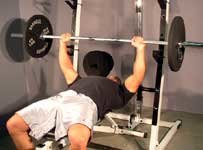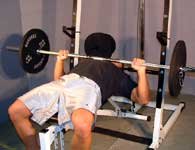Moreover, there is a form of cardio that you are best suited for. No matter how hard you work, the wrong plan will never get the job done. Lets go over how to ascertain what is the best weight training approach for you and how to put it into action.

Fast Twitch Vs. Slow Twitch Muscles 
Muscle fibers are made up of both fast twitch muscle fibers and slow twitch muscle fibers. Individuals that are slow twitch dominant are made for muscular endurance work and tend to get better results with higher set repetitions such as 10-12 per set and fairly low volume, such as three to four sets per exercise.
Alternatively, people that are dominated by fast twitch muscle fibers respond more favorably to heavy repetitions in the three to six-range per set. Moreover, fast twitch masters require higher volume to get the job done. In other words, they need to do lots of sets of low repetitions with heavy weight. Now that you now what the score is, how do you find out what team you play for?
If you are a fan of pain and spending money unnecessarily, you could get a muscle biopsy. On the other hand you could take the following simple test and get a ballpark idea. Let's use the bench press and deadlift for our test. In order to find out what the make-up of your muscle fibers is you will have to ascertain what your one-rep max on the bench press and your one-rep max on the deadlift is.
Calculator |
Instructions:
Enter the amount of weight you lifted (Lbs/Kg) and the number of reps you completed. Your One Rep Max (1 RM) will appear at the bottom left, and your various percentages of 1 RM will appear on the right side.
Now, let's go over how to do both exercises...

Bench Press 
Lie on down on a bench and place your feet firmly on the floor to each side. Do not place your feet on the bench or have them in the air. Move up the bench until the barbell is at eye level. Make sure that you have a spotter whenever you bench press. Have your spotter give you a lift off to get the barbell off of the bench rack.
Lower the barbell to your sternum, pause for a second and press the barbell back to the starting position. Try to press in a straight line rather than an arc. Breathe in as you lower the barbell to your sternum and hold your breath as you press the barbell back to the starting position.
Holding your breath will allow you to get tighter and lift more weight. However, make sure to clear this breathing pattern with your doctor if you have high blood pressure or any heart problems. Holding your breath while training will cause a temporary increase in your blood pressure, so make sure to err on the side of caution.
Some More Tips For A Better Bench Press.
- Crush the barbell as hard as you can on each rep. Imagine that you are trying to rip the bar apart laterally.
- When you press the barbell away from you, imagine that you are trying to push yourself through the floor.
- Flex your legs, butt and stomach while bench-pressing for maximum stability.

Deadlift 
If I could only choose one exercise to train, it would be the deadlift. The deadlift works just about every muscle in the body and will make you stronger and more solid than any other exercise. Executed properly it is completely safe and will ramp the strength in your lower back and legs tremendously. Here is how it is done.
Place a barbell in front of your feet and stand up straight right behind it. Bend over to pick up the bar and as you do, make sure to push your butt out as far as you can as if you are attempting to sit in a chair behind you. Bend your knees slightly and keep your eyes forward at all times. Make sure that your knees track in the same place as your feet. In other words, if your feet are turned out, make sure that you knees go in the same direction rather than letting them buckle inward.
Start the exercise from the bottom up. In other words, start the deadlift, by picking the weight off of the floor. Breathe in right before you pick up the barbell and hold your breath until you stand up completely on each rep. Make sure that you lock out on the top of each rep.
Some Tips To Maximize The Deadlift:
- Crush the barbell as hard as you can on each rep.
- Flex your triceps to ensure that your arms are locked out. Do not shrug the barbell, let the barbell pull your shoulders down.
- Keep the barbell as close to your body as possible on each rep.
- Stand up until your knees are locked out on each rep, but do not lean back at the top of each rep.

Reps & Sets 
For people that have some weight training experience, do a couple warm up sets and gradually increase the weight per set until you reach your one rep max. If you have not been training for at least a few months, then get some training experience under your belt before you take this test.
As a beginner, you will benefit from just about any program that you can do consistently, so do not worry about personalizing training yet. Just get used to training and then come back in a few months to take it to the next level.
For those of you that can go forward, take 80% of your one-rep max and do as many repetitions as you can. If you only get five reps or less then you fall into the fast twitch world. If you get ten reps or more, than you are a slow twitch rider.
Finally if you get six to eight reps, then you have an equal number of fast and slow twitch fibers. As Sun Tzu writes in the "Art Of War" the key to winning any battle is to know yourself and your enemy. Now that you know what muscle fiber-type you are, you know how to attack your enemies: fat and weakness.
 |
||||
 |
|
 |
||
 |
||||
Some Guidelines To Follow For Each Muscle Fiber Type.
-
Fast Twitch:
-
Do six to eight sets of three to five reps on each exercise two times per week. Stick to compound exercises such as the bench press,
squat, and deadlift.
For cardio, your weapon of choice is interval training. An example of interval training is running at full speed on a treadmill for twenty seconds, followed by ten seconds at a moderate pace. Do five to ten intervals per workout three times per week if you main goal is fat loss.
Slow Twitch:
-
Do two to three sets of eight to ten on each exercise three times per week. Again, stick to compound exercises.
For cardio, do interval training as well with less focus on fast twitch fibers. Try 20 seconds running at full speed, followed by one minute at a moderate pace.
Slow/Fast Twitch:
-
Do four sets of five to seven reps two to three times a week. Try full body workouts with a focus on compound exercises.
For cardio, do interval training with thirty seconds at full speed, followed by thirty seconds at a moderate pace.

Conclusion 
Now there are no more excuses. Find out what muscle fiber type you are dominant in and follow the best plan you're your body type.
About The Author
Mike Mahler is a strength coach and a certified kettlebell instructor based in Santa Monica, California. For more information on Mike click here.






